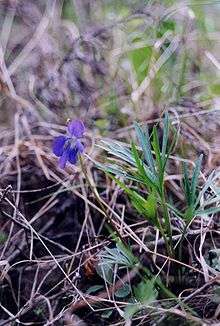Viola pedatifida
| Prairie violet | |
|---|---|
 | |
| Scientific classification | |
| Kingdom: | Plantae |
| (unranked): | Angiosperms |
| (unranked): | Eudicots |
| (unranked): | Rosids |
| Order: | Malpighiales |
| Family: | Violaceae |
| Genus: | Viola |
| Species: | V. pedatifida |
| Binomial name | |
| Viola pedatifida G.Don | |
Viola pedatifida (prairie violet, crow-foot violet, larkspur violet, purple prairie violet, coastal violet; syn. Viola pedatifida subsp. brittoniana (Pollard) L. E. McKinney, Viola pedatifida G. Don subsp. pedatifida,[1] Viola palmata L. var. pedatifida (G.Don) Cronquist[2]) is a perennial herbaceous plant in the Violet family (Violaceae). It is 4-8in. (10–20 cm) tall with pale purple flowers and deeply divided leaves. Prairie violet is native to North America.[3]
The specific epithet pedatifida means "pedately-cleft" in botanical Latin, in reference to the leaves, which look like a bird's foot with the outer toes again parted. Prairie violet was described for science in 1831 by the Scottish botanist George Don (1798–1856)[4]
References
- ↑ Germplasm Resources Information Network Retrieved 2010-03-12.
- ↑ Robert W. Freckmann Herbarium University of Wisconsin - Stevens Point Retrieved 2010-03-12.
- ↑ Lady Bird Johnson Wildflower Center Retrieved 2010-03-12.
- ↑ Northern Prairie Wildlife Research Center Retrieved 2010-03-12.
This article is issued from Wikipedia - version of the 8/5/2015. The text is available under the Creative Commons Attribution/Share Alike but additional terms may apply for the media files.